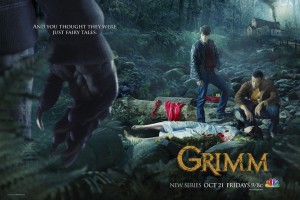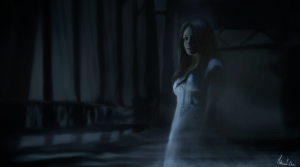La llorona is a widely known story across different countries, ethnicities, and has multiple origins, but the basic premise holds similar in most of them: of a woman who kills her children and then commits suicide because her husband was unfaithful, and then she continues to roam the earth in another worldly form crying and taking any children who misbehave or are out late.
Supernatural and Grimm are both spirit/supernatural-related shows that deal with humans who have to fight to keep humanity safe from other worldly beings. Both of these shows took on the case of La Llorona, but approached it in different ways, while at the same time covering similar aspects of La Llorona’s origin story.
GRIMM
Grimm is a procedural cop show/ fantasy drama that follows Detective Nick Burkhardt, who is a “Grimm”- a guardian entrusted with protecting humanity from supernatural/mythical creatures called “Wesen.” Along with the help of his partner Detective Hank Griffin (regular cop who later learns of Nick’s activities and begins to help him), Monroe – a “Wesen” that helps Nick with information on the underground supernatural world- and Juliette- Nick’s girlfriend, Nick works his regular cop cases whilst also combatting mythical creatures.
La llorona is introduced (Season 2 Episode 9 “La Llorona”) at a river bank, where a father and son are fishing. La llorona begins to cry and walks into the river and the father runs to save her, but when he does, La Llorona disappears, reappears next to the father’s son, and walks away with him. In this show, La Llorona is brought in as an actual criminal case of a woman who is abducting children in three’s around the country and people can actually see her. La llorona takes two boys, one girl, between the ages 7-10 every Halloween, and drowns them before midnight in a river that meets where she abducted them from. La Llorona is portrayed as a pretty woman wearing white, with long hair, and cries blood, but when a person gets too close, her face turns to a hideous one.
The grandmother of the kidnapped boy (Rafael) brings up the story of La Llorona to the Detectives and speaks about how La Llorona steals kids and drowns them because she drowned her own children, and repeats it over and over to try and bring back her children. On a curious side note, the grandmother speaks to Detective Nick’s girlfriend about her encounter with things she doesn’t understand that “aren’t from this world”. I saw a connection with this grandmother and Bless Me Ultima because in both, there is an older woman who appears to know and believe in other worldly things while those around them choose to ignore it.
In this show, La llorona is given an estimated origin or first sighting; a book Nick looks into has a recording as back as 1519 in Veracruz of a “Woman in the River”. She was named this because she would drown the children at the “abrazo del rio”- the river’s embrace.
In the climax of the episode, Nick battles La Llorona in the river, and she begins to pull him down with her (she also reveals her true face). Nick begins to strangle her and La Llorona’s face turns back to a human face and then she disappears into the river. When detective Burkhardt asks whether or not it’s over, the female detective says “we’ll have to wait until next year,” so the resolution is left inconclusive (although the children were saved).
SUPERNATURAL
Supernatural is a fantasy, action/adventure drama television series that follows Sam and Dean Winchester, two brothers that hunt all things supernatural (demons, angels, and all folklore creatures) because it is a family business that dates back generations. La llorona is introduced in Season 1 Episode 1 (“Pilot”) as the first case that the two brothers tackle in the hopes of finding their father who has been missing for a week after taking on the case on his own.
The case begins with a woman in white on the side of highway 99 that asks to get taken home by a passerby, which he says yes to (woman in white is flirting with the guy). The woman is acting provocatively and then says “will you come home with me?” and the guy says yes. When they arrive to an old, broken down home, the woman says “ I can never go home,” disappears, and then murders the guy but leaves no form of evidence or a body, but does leave blood stains in the car.
The story of the woman in white began in that particular small town in 1981 when a woman, Constance Welch, killed herself because she drowned her two children because her husband cheated on her. The woman in white is also mentioned by the Winchester brothers to be called “The Weeping Woman” and that there are multiple weeping women spirits all over the country, not just one, and that they are created when a woman dies a violent death. This woman in white chooses her victims on whether or not they are unfaithful (like her husband), which is why when she appears to the men on highway 99, she acts provocatively (and looks pretty) to entrap the man to cheating and then she murders them (which is also when she reveals her true ugly form). The woman murders the men by sticking her hand into the victims’ chests and pulling out their hearts, but can only do so if they are unfaithful.
In the battle between the Winchester brothers and the Weeping Woman, Sam drives their car- with the woman attacking him inside – into the woman’s old house, and when they do so, the woman’s children appear in spirit form too, with water dripping down the stairs. The woman begins to cry and scream as her children drag her up the stairs and disappear into a large white flash. The Winchester brothers deduce that the weeping woman always said she couldn’t go home because of her guilt of murdering her children, and once she was taken home, the spirits of her children took vengeance on her and dragged her away (to the spirit world?).
SIMILARITIES AND DIFFERENCES BETWEEN THE TWO INTERPRETATIONS
One major difference that the two interpretations had was that Grimm’s interpretation of “La Llorona” was a Hispanic woman who did speak Spanish and was actually labeled as “La Llorona with an estimated Latin origin in Veracruz, 1519, but Supernatural’s interpretation labeled her as “The Woman in White” and appeared to be Caucasian with no apparent Hispanic connection with multiple origins and having multiple Lloronas across the country. I think that the reason that Supernatural created an English speaking llorona is to appeal to people that are not of Hispanic ancestry because since the story appears to have Hispanic origin, creating an English version will broaden La Llorona to even more regions.
The target group and killing method that La Llorona used in each television show was varying as well. La llorona in Grimm kidnapped three children every Halloween (only on Halloween) and drowned them in specific locations as a tribute attempting to get her children back – she says “mis hijos, vengan” and asks those children to take their place.
In Supernatural, La llorona kills only males that come on to the woman because her killing method is to murder all adulterous men. It’s also interesting that Supernatural’s version can (as a spirit) take control of objects and vehicles, whereas the Grimm version does not appear to be able to do so.
Another difference is the way that the case was solved for each version. In Grimm’s interpretation, La llorona disappears into the river after her fight with Detective Nick with no apparent sign of having been beaten or destroyed. In Supernatural, the Winchester brothers take La llorona home and she is dragged away by her vengeful ghost children, which can be seen as a conclusion to that particular woman (since there are multiple weeping women throughout the country).
A similarity that both versions do share is that the woman is very beautiful from afar, and from up close as well, but only long enough to gain trust of her victim, and then her face turns in to a hideous (true) face. This is consistent with the stories of La Llorona that have been told through other television shows, film, and stories.
Both of these interpretations share the same elements that have followed the stories of La Llorona (woman murders her children because of an adulterous husband, commits suicide, is pretty from afar but ugly up close, and can’t truly be killed). Both Grimm and Supernatural created interesting and vivid visual interpretations of the story of La Llorona while also adding their own respective uniqueness to them, and in my opinion, are two actually good representations of a tale of La Llorona (in comparison to many bad interpretations which I will discuss in the later posts).
Works Cited:
http://grimm.wikia.com/wiki/File:209-La_Llorona2.png
http://grimm.wikia.com/wiki/File:209-la_Llorona_blood_tears.png
http://www.cwtv.com/shows/supernatural/
http://www.nbc.com/grimm
http://en.wikipedia.org/wiki/Grimm_(TV_series)
http://en.wikipedia.org/wiki/Supernatural_(U.S._TV_series)








